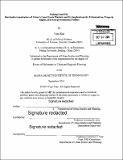| dc.contributor.advisor | Annette M. Kim. | en_US |
| dc.contributor.author | Xiao, Yuan, Ph. D. Massachusetts Institute of Technology | en_US |
| dc.contributor.other | Massachusetts Institute of Technology. Department of Urban Studies and Planning. | en_US |
| dc.coverage.spatial | a-cc--- | en_US |
| dc.date.accessioned | 2015-02-25T17:11:35Z | |
| dc.date.available | 2015-02-25T17:11:35Z | |
| dc.date.copyright | 2014 | en_US |
| dc.date.issued | 2014 | en_US |
| dc.identifier.uri | http://hdl.handle.net/1721.1/95581 | |
| dc.description | Thesis: Ph. D. in Urban and Regional Planning, Massachusetts Institute of Technology, Department of Urban Studies and Planning, 2014. | en_US |
| dc.description | Cataloged from PDF version of thesis. | en_US |
| dc.description | Includes bibliographical references (pages 257-267). | en_US |
| dc.description.abstract | This dissertation investigates China's land quota markets, a recent land policy innovation that virtually transfers urbanization permission from the countryside to cities. To circumvent national government's quota restrictions on converting agricultural land to urban land, local governments have created new land quotas by demolishing sparsely located farmhouses, and resettling peasants into high-density apartments. These quotas are then sold in new land quota markets to real estate developers. I find that China's land quota markets alter the traditional calculus of location and land use theory: the rural hinterlands have suddenly become valuable to urban land markets, particularly for industrial projects. In fact, the more distant a village is, the more likely it will be involved in land quota markets. Remoteness becomes a spatial advantage. These dramatic changes are the result of reconstructing property rights in land. The quotas traded on the market are a right to convert land use from rural to urban, separate from development rights to invest in specific properties. These institutional changes were initiated by recalibration of inter-governmental relationships: the Central Government delegates more autonomy to local governments and the municipality centralizes control over land from subordinating district and county governments. The implications of the new land quota markets are profound and many. The quota markets further draw land resources away from the rural areas to urban areas, and reinforces the imbalances between big and small cities. Since these institutional changes are driven by public finance at its core, the scale of our analysis needs to be regional rather than at the scale of the city. Lastly, quota markets have mixed welfare impact on different types of peasants. For peasants on the urban fringe, the scale of land taking is likely to increase, displacing more peasants than without the quota markets. For peasants in the deep rural areas, their housing conditions and access to infrastructure and public services are improved. However, their transition to urban lifestyle takes place before their transition to urban mode of production, therefore their long-term economic prospect is dismal. | en_US |
| dc.description.statementofresponsibility | by Yuan Xiao. | en_US |
| dc.format.extent | 267 pages | en_US |
| dc.language.iso | eng | en_US |
| dc.publisher | Massachusetts Institute of Technology | en_US |
| dc.rights | M.I.T. theses are protected by copyright. They may be viewed from this source for any purpose, but reproduction or distribution in any format is prohibited without written permission. See provided URL for inquiries about permission. | en_US |
| dc.rights.uri | http://dspace.mit.edu/handle/1721.1/7582 | en_US |
| dc.subject | Urban Studies and Planning. | en_US |
| dc.title | Making land fly : the institutionalization of China's land quota markets and its implications for urbanization, property rights, and intergovernmental politics | en_US |
| dc.title.alternative | Institutionalization of China's land quota markets and its implications for urbanization, property rights, and intergovernmental politics | en_US |
| dc.type | Thesis | en_US |
| dc.description.degree | Ph. D. in Urban and Regional Planning | en_US |
| dc.contributor.department | Massachusetts Institute of Technology. Department of Urban Studies and Planning | |
| dc.identifier.oclc | 903643517 | en_US |
